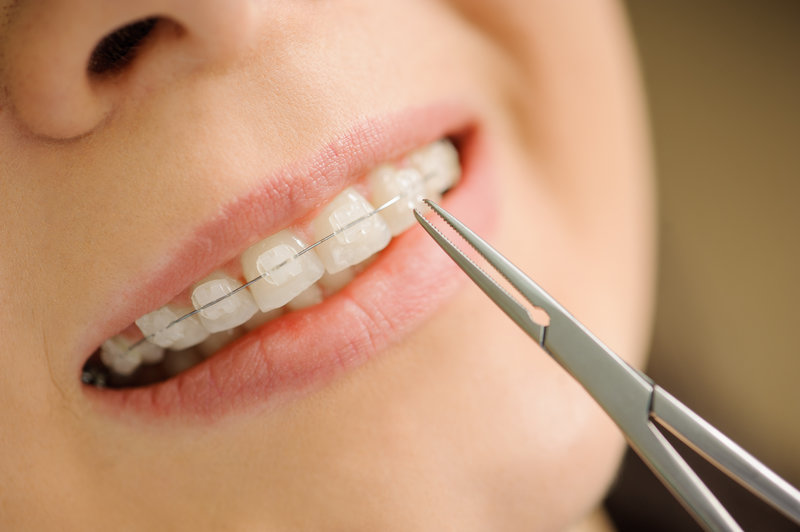Ceramic Braces vs. Traditional Metal Braces
Pros to Receiving Orthodontic Care
July 14, 2017Why Is Pediatric Dentistry So Important?
July 29, 2017
Close-up ceramic braces on teeth at the dental clinic. Dentist holding dental tool. Orthodontic Treatment.
When it comes to traditional metal braces, should you stick to silver wires and brackets or go for clear ceramic braces? If you aren’t familiar with ceramic braces, they are a twist on the traditional metal brackets we know and love. If aesthetics are important to you (or how your smile looks), then ceramic braces will be an option you love. Traditional metal braces consist of the silver brackets and wires most teenagers and even adults wear. Ceramic braces have certain health benefits that traditional metal brackets don’t have, such reducing the risk of demineralization of your teeth around the brackets. Come learn more about the differences between our ceramic braces and traditional metal brackets and see what option you prefer!
Fun Facts About Braces
Braces of all types have become more and more popular throughout the years. There are over 4 million people (around 4.5 million) in the United States alone that wear braces. We’re not just talking about teenagers either! About 25% of all people with braces are adults, and that number is rising each year. Adults are investing in the straightening power more and more each year because of the success and confidence it can bring them in social settings and professionally. Some studies show that straighter teeth can help patients do better in school, with their peers, and even professionally as an adult. Those with straighter teeth have been shown in studies to land a job easier over someone with a crooked smile as well.
Many people receive orthodontic treatment between the ages of 10-14. This is an ideal time where the head and mouth are still growing and teeth are easier to straighten. However, many children also receive early orthodontic care between the ages of 7-8. It’s never too late to receive orthodontic care though, which is why so many adults also choose to receive braces.
Braces Options
When you think of braces, you probably think of traditional metal braces that so many people wear. In the past, there was only traditional metal braces that people could receive to straighten their teeth. However, today there are several types of braces you can get when it comes to orthodontic care. These include:
- Traditional Metal Braces
- Clear Ceramic Braces
- Invisalign Transparent Aligners
- Incognito Lingual Braces
You can also receive retainers after you’ve had braces that are permanent or removable. Some of our most popular options are traditional metal braces and their close cousin: clear ceramic braces.
Traditional Metal Braces
These are the braces most people think of when they think “braces.” Traditional metal braces consist of metal brackets with a wire on the top set of teeth and along the bottom set of teeth. This is called the archwire. Metal brackets are placed on each individual tooth and bonded with a special glue that keeps them in place without hurting your tooth enamel. The archwire goes through each bracket and keeps the brackets in place. This archwire is also what helps the teeth move into proper alignment throughout the months you have traditional metal braces.
These braces are made from stainless steel, but can also be made of titanium. The most noticeable part about traditional metal braces is that they are front and center on the teeth where they can be seen. However, they are the cheapest option when it comes to receiving amazing orthodontic care, making this option so popular.
Clear Ceramic Braces
At our office, we offer you Clarity ADVANCED Ceramic Braces by 3M. This is a revolutionary system designed to be reliable, safe and enduring. Our clear ceramic braces are very similar to traditional metal braces except for their appearance and what they are made from. Ceramic braces are made of a strong ceramic material (hence the name). Ceramic material is already white, so when we use it to create a set of beautiful braces on your teeth, they become almost unnoticeable. Both the brackets and even the archwire can be made white so they blend right in. Ceramic braces are also very beneficial to the teeth because their material decreases the risk of demineralization from bonding agents and brackets. They do cost just a bit more than traditional metal brackets do, but you gain the benefit of how well the braces blend into your teeth.
Get Your Braces Today
Both our ceramic braces and traditional metal brackets are amazingly strong and will give you a smile you’ll adore. Both can be coupled with colorful bands and dressed up the way you want them. If you are ready to receive your traditional metal braces or clear ceramic braces, call our Hardy Pediatric Dentistry & Orthodontics office today at (720) 887-6003!
